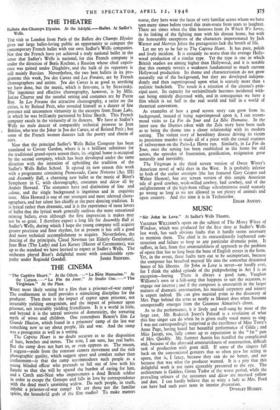THE CINEMA
" The Captive Heart." At the Odeon. —" La Bete Humaine." At the Curzon.—" La Fin du Jour." At Studio One.—" The Virginian." At the Plaza. '
WHAT more likely setting for a film than a prisoner-of-war camp? The confinement in itself provides a stimulating discipline for the producer. Then there is the impact of captor upon prisoner, not invariably yielding antagonism, and the impact of prisoner upon prisoner, not invariably yielding friendliness. It is a world in little, and beyond it is the unreal universe of domesticity, the torturing myth of wives and children. One remembers Renoir's film La Grande Illusion, which found in a prisoners' camp of the last war something new to say about people, life and war. And the camp was a protagonist as well as a setting. The Captive Heart is no doubt accurate as to the disposition of huts, benches and stoves. The wire, I am sure, has real barbs. But the camp does not hurt us, or even oppress us. The reason; I suggest—aside from the constant camera movement and the rich photographic quality, which suggest space and comfort rather than confinement—is that the camp accommodates such people as a young blinded officer who pretends to fall out of love with his fiancée so that she will be spared the burden of caring for him, and a Czech anti-Nazi who impersonates a dead British soldier in order to escape the Gestapo and falls in love by correspondence with the dead man's unwitting widow. Do such people, in truth, inhabit a prisoner-of-war camp? Or are these not the familiar spirits, the household gods of the film. studio? To make matters worse, they here wear the faces of very familiar actors whom we have seen many times before travel this tram-route from tears to laughter. There are times when the film borrows from In Which We Serve, in its linking of the fighting man with his distant home, but with the honourable exceptions of the characters impersonated by Jack Warner and Mervyn Johns the protagonists lack the breath of life.
Let me try to be fair to The Captive Heart. It has pace, polish and lively incident. It is certainly no worse than the average Holly- wood production of a similar type. Yet the type is one in which British studios are aiming higher than Hollywood, and it is notable that this example reveals a weakness fundamental to much current Hollywood production. Its theme and characterisation do not grow naturally out of the background, but they are developed indepen- dently and then superimposed upon what is scarcely more than a realistic backcloth. The result is a rejection of the cinema's prin- cipal asset. Its capacity for verisimilitude becomes incidental with- out being entirely dispensed with, and in consequence we have a film which is set half in the real world and half in a world of theatrical convention.
As examples of how a good screen story can grow from its background, instead of being superimposed upon it, I can recom- mend visits to La Fin du Your and La Bite Humaine. In the latter case the liberties taken with the Zola story have been such as to bring the theme into a closer relationship with its modem setting. The violent story of hereditary disease driving its victim to passionate murder is made all of a piece with the casual routines of railwaymen on the Paris-Le Havre run. Similarly, in La Fin du Your, once the setting has been established in the home for old actors, the episodes of frustration, gratification, resignation grow naturally and inevitably.
The Virginian is the third screen version of Owen Wister's American novel of wild days in the West. It is probably inferior to both of the earlier attempts (the last featured Gary Cooper and Walter Huston), but any screen version of this simple American tale of good cowboy, weak-willed cowboy, bad cowboy, and of the enlightenment of the high-born village schoolmistress could scarcely go wrong so long as we are allowed to see plenty of animals and open country. And this time it is in Technicolor.
EDGAR ANSTEY.


























 Previous page
Previous page